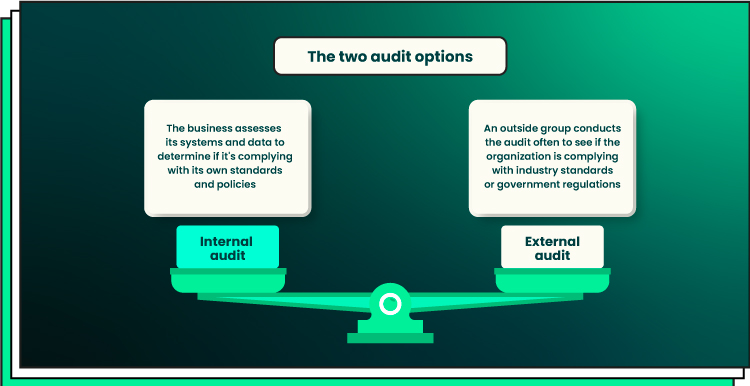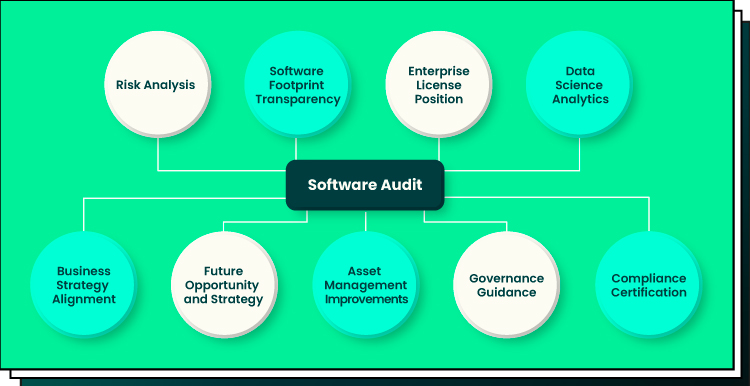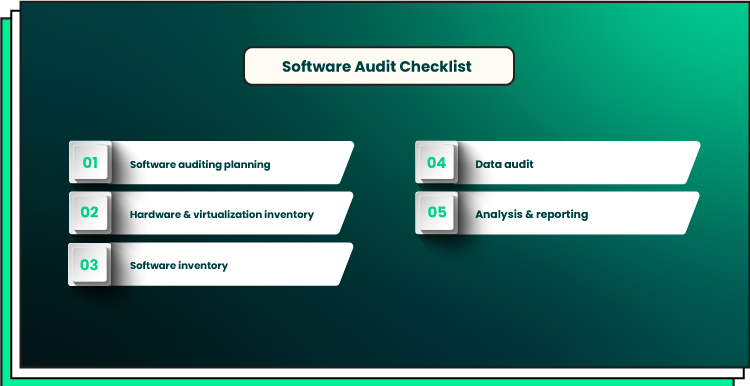In this article, we explore the essence of a software audit, discover the benefits and tips of software auditing, and help you decide if you need to conduct it right now.
The software development life cycle (SDLC) is a complex process comprising numerous steps, from planning and estimation to support and maintenance. In full-cycle development, post-release efforts are as important as digital testing and quality assurance during the very product creation.
From time to time, it’s important to collect user feedback and return to improving, testing, and enhancing your software products. Your regular post-release effort should be accompanied by well-organized software audits. Such a procedure will help you reveal the gaps and strengths of your software product and maintain a competitive advantage.
Outside of the SDLC context, software code audit is no less important. Whether you use custom-built or on-premises software, it’s crucial to regularly check if it fully meets your requirements. By requirements, we mean the features you use as well as security regulations, privacy policies, requirements for system parameters, etc. All this can be checked with the help of a comprehensive procedure — software auditing.
What Is Software Audit? Meaning and Use
Software audit is the process of software checkup organized and conducted by you (which is an internal audit) or by a third-party company (external audit). If performed by an external software vendor, this service is also known as technology due diligence. It involves a third-party software development company that conducts an audit of your software and hardware and tests it against the set of requirements.
A software code audit is like the health check of your digital business infrastructure. It helps you prevent issues, spot problems and bugs promptly, and maintain a high level of user satisfaction with the product. Regular software audits will save you a fortune and help you keep your technology up and running. The procedure is also helpful when scaling as it helps you find the new user needs or gaps to be satisfied with your product.
Software Auditing Benefits
Companies audit their software stacks to cut costs, comply with legal requirements, and be aware of the overall state of their infrastructure. Here is a more detailed overview of the benefits you can get with auditing:
Don’t pay for the tools that are not in use
Each team in your enterprise is focused on their goals and duties and each uses their own set of tools to reach these goals. Some tools may be not in use for a long time and should be replaced by better options. However, you keep paying for monthly or yearly subscriptions for these tools. To prevent this from happening, you should regularly conduct a software code audit.
By conducting software audits, you will uncover the tools and software pieces that you don’t use and remove the unnecessary licenses from your expenses list. You will check the tools in use and analyze if they are worth paying for or if there are some better options on the market.
Make essential improvements
Software code audit will help you find the tools and software pieces to improve. This can be done by customizing the tool to your needs, upgrading the subscription plan, extending the tool’s functionality, etc. The strategy depends on the type of software you use and the essence of an audit.
As a part of the software auditing process, security checks and vulnerability testing will help detect the weaknesses of your software and find powerful ways to protect your and your client’s data. Based on the findings, your software audit team will decide on the fate of each particular tool.
If you are looking for help with this task, consider hiring software consultants from Forbytes. Our experts have a deep understanding of the performance and security subtleties of niche-focused systems. We will carefully review the code and make enhancements to boost your security and performance.
Keep your software licenses in order
As said above, keeping track of your licenses can save you money and prevent compliance gaps. What’s more, it can also prevent legal issues associated with an outdated software license. It can happen that you stop using your software or it becomes non-functioning. However, you are obliged to pay for the licensing if the contract says so. If you don’t want to pay for the tools you don’t use, you will have to terminate the contract.
A software audit involves the phase of reviewing all your software license contracts and related documentation. By keeping a record of regular checks and software audits, you will always be aware of the industry standards, changes in the legal requirements, and mutual obligations between you and your software provider.
Increase business efficiency
Software audit is a comprehensive process of checking your software, having an impact on your business as a whole. To make sure that the software meets your expectations, you will have to state your expectations first. This process requires a team of tech experts to conduct a review of your business operations and find the perfect tools to perform the business tasks. During such a review, they can detect performance gaps or come up with ideas on how to optimize your operations.
So, software audits give you the chance to look at your business from a bird’s eye view and retrospectively evaluate your business processes. What’s more, a software code audit can also lead to significant financial savings. You get the chance to improve the operation efficiency, cancel the subscriptions to unnecessary tools, generate insights on your performance, and more.
5 Tips to Prepare for Software Audits
Now you know the answer to the question “Should companies audit their software?” The answer is “yes,” whether you are a product company and offer tech solutions to others or purchase products by yourself. Here are some practical tips from our team to help you prepare for the software audit.
Keep a record of your software performance
To make it easier for software auditors to conduct a software code audit in the future, take care of your performance records. Whenever your team or users experience issues while using the software, capture the problem in your records. This will help you evaluate the state of your software before planning and conducting the audit.
Collect the team’s feedback
For conducting a software audit, you will have to make a list of the tasks that the software has to perform. Then, compare the list with the actual features and functions offered by the software vendors of your choice. At this step, you should collaborate with your teams to hear what they think about the software from a practical viewpoint. Ask them if they wish to have some additional features in the software or if some features are useless.
Make it a habit
Software auditing shouldn’t be a one-time procedure; you should conduct a software code audit regularly. It should become a vital part of your business routine. If you conduct software checks systematically, you will achieve the best results. Your software will be up-and-running, secure, and performant, your licenses will be up-to-date, and your team will get the most effective toolset to perform their tasks.
Use effective SAM tools
SAM stands for software asset management. SAM tools help you automate management and software maintenance. By 2030, the internal auditing software market is projected to grow to $2,535 million, marking a growing popularity of such tools among businesses.
With the help of software auditing tools, you can document and keep track of your software licenses, organize inventory processes, access statistics, improve data center management, and more. Contact us to get help with choosing the best-of-breed SAM software to cover all your needs.
Hire a reliable software audit vendor
Good for you if you have an in-house team ready to dedicate their time to software auditing. If you don’t, high chances are that you’ll need the help of an expert software development and consulting team. That’s because of several reasons.
First, they have a deep understanding of what quality code looks like and know how to enhance audit management to bring the best outcomes. Second, they are well acquainted with the top on-premises and off-the-shelf software on the market and can help you select the best options to meet your needs and fit into the budget. Thirdly, such a team knows all the subtleties of the legal side of the question. They will do their best to make sure you comply with all security and privacy regulations, legal rules, and industry requirements.
Forbytes has more than 12 years of experience in software engineering and tech consulting. Our team will be at your disposal to guide you through the software code audit from start to finish. Contact us to discuss the optimal software audit phases in your case.
How to Conduct Software Audit in 5 Steps
The process of software code audit can be changed, extended, or narrowed depending on the software tools you use, the purposes of software use, your business expectations and goals, etc. The following 5 steps typically form the ground for an effective software audit process. They include:
Step 1. Software auditing planning
Start by outlining the purpose of your audit. Although it usually covers all the aspects (like security, performance, expenses, legal requirements, software risks mitigation, etc.), you can prioritize the aspect that raises a lot of concerns. Then, make a list of all the hardware and software pieces that will be audited. Also, include virtual technology in the list. If you conducted internal audits before, attach the documentation to the new project.
Use all the data that you collect to plan out the software audit project and break it down into phases. Each phase will be focused on a particular type of technology or a particular aspect to check. In our case, we subdivided the audit into hardware & virtualization inventory, software inventory, and data inventory.
Step 2. Hardware and virtualization inventory
This software code audit step involves checking the hardware your team uses at work. After checking the hardware details (like the model and characteristics), the team will check if the hardware performs well and is up to date. You will also be informed in case any hardware piece needs to be updated or replaced.
At this step, you will also focus on the virtual technology, e.g., virtual servers, environments, or virtual machines, that run on physical servers. An experienced software engineering team will prepare the documentation for checkups and help you evaluate the capabilities of this technology.
Step 3. Software inventory
Then, software auditors move to the software inventory. Start the software audits by documenting the list of software tools, systems, and software products you use on your hardware. Mention the details concerning each software piece in your documentation, including the provider’s name, product name, version, edition, etc.
Step 4. Data audit
This step is dedicated to a data-related audit. At this step, you will review the security and confidentiality of your data that is leveraged in the software. Skipping this step may result in growing risks for your company. Data Breach Report states that as of 2022, nearly 400 million people were affected by 4.5 data breaches daily.
Usually, software publishers display data policies on their websites. Check them to make sure that your user data is well-protected, and that the software vendor complies with the industry standards.
Step 5. Analysis & reporting
Structure and organize all the data you collected during the software audit. Leverage the essential metrics and key results in reporting. Prepare reports that are insightful and easy to grasp. Make sure that they provide the key information and won’t take a lot of time from your team if the latter decides to refer to them in the future.
Use the documentation from the audit to make positive changes in your organization. For example, find better software options, upgrade the tools you use, organize extra training for your employees on the new features, etc.
How Can Forbytes Help?
After reading this piece, you know the answer to the question “Should companies audit their software stacks?” In this article, we discussed the benefits, reasons, and steps of conducting a basic software audit. The tips we share are generic and will be adjusted to the needs and objectives of each particular client.
To discover how to organize the software auditing process in your case, get in touch with our team. By referring to software audit experts once, you will lay the foundation for performing software audits in the future.

Our Engineers
Can Help
Are you ready to discover all benefits of running a business in the digital era?

Our Engineers
Can Help
Are you ready to discover all benefits of running a business in the digital era?













